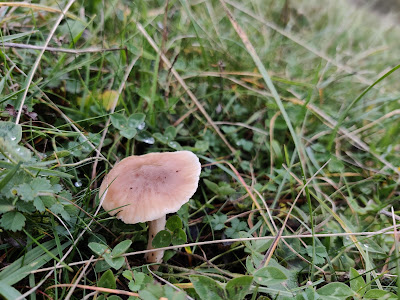Had a day off from the desk job today, so took myself out for some exercise on Southwick Hill.
I've been spending some time recently reviewing old records of waxcap fungi in Sussex and this site had popped up on my radar as one which has had a good number of species recorded from here previously. Plus it's Open Access, so ideal for exploring. (You can see where the Open Access land is on this rather clunky online map.)
There's an access point via a little twitten off Oakdene Close in Mile Oak, on the northern fringe of Brighton & Hove.
... past some anachronistic graffiti.
The path brings you straight out onto an area of rough chalk grassland.
Around about here I spotted my first waxcaps of the day: Blackening Waxcap Hygrocybe conica
Classic fresh young conica there. Just starting to blacken on the edge of the cap. They were the only two I saw all afternoon!
After that it was just beige ones...
Here's a close-up of the fruit body pictured at the top of this blog on the hill above Mile Oak.
The warm brown tones reminded me of Toasted Waxcap Cuphophyllus colemannianus but when I took a look at the gills they didn't appear 'intervenose' like I've seen on that species before.
The stipe was also slightly grey-brownish (colemannianus is characteristically white)...
... so now I'm wondering if this is more like Cuphophyllus virgineus var. ochraceopallidus — the buff coloured variety of Snowy Waxcap which occurs on calcareous grassland.
***
Here's another slightly more beige thing.
Nice arcuate decurrent gills on this one.
Cuphophyllus virgineus var. ochraceopallidus?
***
Further up the hill, above the Southwick Tunnel, another patch of pale waxcaps.
These look like classic Snowy Waxcap Cuphophyllus virgineus with the more pure white colour and elegant decurrent gills.
***
On a mossy bank by the side of the track that leads to Mile Oak Farm, some subtly different ones.
With that brownish spot in the centre of the cap (and no scent of cedarwood that I was able to discern) I thought these might be Cuphophyllus virgineus var. fuscescens — another variety that Boertmann describes as occuring on calcareous grassland.
***
I was interested to read in the Project Waxtongue final report (here) that Hygrocybe virginea (=Cuphophyllus virgineus) was found to contain at least seven cryptic, but distinct, phylogenetic taxa.
So I wonder how many different 'species' I've seen today...?
***
That was it, waxcap-wise. I also came across a patch of rather lovely-looking Entoloma.
I was struck by how dark they appeared, but I don't suppose I'll be able to make anything of them.
***
The grassland varies considerably across the site. Up along the top path the sward is much lusher and longer (more nutrient rich?)
Pretty sure this is Stubble Rosegill Volvopluteus gliocephalus...
... you can just see here the top of the bag-like volva at the base of the stipe. Yellow Fieldcap Bolbitius titubans was popping up in places as well.
These species love nutrient-rich grassland, so I wouldn't expect to find any waxcaps around where they're growing.
***
That was my first visit to Southwick Hill. You get a sweeping view at the top of the Downs, the sea and a big building site on the edge of Brighton & Hove.
Worth a trip back to look again for waxcaps though, I reckon. Will see if I can sort out survey permissions — so I can get some of those cryptic beige waxcaps under the microscope.
For the record
Date: 11 November 2020
Location: Southwick Hill, Mile Oak




















Hi Clare - It looks to me like the first one is colemannianus; the gills don't look decurrent enough for a variety of virgineus and the stipe can be pale brown as well as white. The second one does look like var ochraceopallida. A great find - I have only seen it twice
ReplyDeleteJon Dunkelman